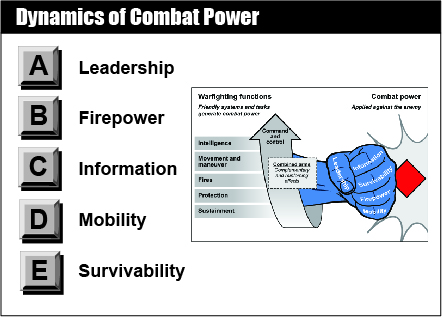Combat power is the total means of destructive and disruptive force that a military unit/formation can apply against an enemy at a given time (JP 3-0). It is the ability to fight. The complementary and reinforcing effects that result from synchronized operations yield a powerful blow that overwhelms enemy forces and creates friendly momentum. Army forces deliver that blow through a combination of five dynamics. The dynamics of combat power are—

Leadership is the most essential dynamic of combat power. Leadership is the activity of influencing people by providing purpose, direction, and motivation to accomplish the mission and improve the organization (ADP 6-22). It is the multiplying and unifying dynamic of combat power, and it represents the qualitative difference between units. Leadership drives C2 but is also dependent upon it. The collaboration and shared understanding inherent in the operations process prepare leaders for operations, expand shared understanding, hone leader judgment, and improve the flexibility that leaders apply to the other dynamics of combat power against enemy forces.
The complementary and reinforcing effects that result from synchronized operations yield a powerful blow that overwhelms enemy forces and creates friendly momentum. Army forces deliver that blow through a combination of five dynamics: leadership, information, survivability, firepower, and mobility.
All warfighting functions contribute to generating and applying combat power. Well sustained units able to move and maneuver bring combat power to bear against the opponent. Joint and Army indirect fires complement and reinforce organic firepower in maneuver units. Survivability is a function of protection tasks, the protection inherent to Army platforms, and schemes of maneuver that focus friendly strengths against enemy weaknesses. Intelligence determines how and where to best apply combat power against enemy weaknesses. C2 enables leadership, the most important qualitative aspect of combat power.
The Human Dimension
For Army forces, an operational environment includes portions of the land, maritime, air, space, and cyberspace domains. Understanding the physical, information, and human dimensions of each domain helps commanders and staffs assess and anticipate the impacts of their operations.
Operations reflect the reality that war is an act of force (in the physical dimension) to compel (in the information dimension) the decision making and behavior of enemy forces (in the human dimension). Actions in one dimension influence factors in the other dimensions.
The Human Advantage
The human dimension encompasses people and the interaction between individuals and groups, how they understand information and events, make decisions, generate will, and act within an operational environment. The will to act and fight emerges from the complex interrelationship of culture, emotion, and behavior. Influencing these factors—by affecting attitudes, beliefs, motivations, and perceptions—underpins the achievement of military objectives.
Commanders and staffs identify relevant actors and anticipate their behavior. Actors are individuals, groups, networks, and populations. Relevant actors are actors who, through their behavior, could substantially impact campaigns, operations, or tactical actions. From this understanding, commanders develop ways to influence relevant actor behavior, decision making, and will through physical and informational means.
A human advantage occurs when a force holds the initiative in terms of training, morale, perception, and will. Human advantages enable friendly morale and will, degrade enemy morale and will, and influence popular support. Examples of human advantages include leader and Soldier competence, morale of troops, and the health and physical fitness of the force. Forces with a cultural affinity to the population in which they operate are also a form of a human advantage. For Army forces, the mission command approach to C2 is a significant human advantage that enhances the friendly decision cycle.
 This article is an extract from "TLS7: The Leader’s SMARTbook, 7th Ed. (Leadership as a Dynamic of Combat Power)" by The Lightning Press. Download a free PDF sample and learn more at: TLS7: The Leader’s SMARTbook, 7th Ed. (Leadership as a Dynamic of Combat Power).
This article is an extract from "TLS7: The Leader’s SMARTbook, 7th Ed. (Leadership as a Dynamic of Combat Power)" by The Lightning Press. Download a free PDF sample and learn more at: TLS7: The Leader’s SMARTbook, 7th Ed. (Leadership as a Dynamic of Combat Power).
Browse additional military doctrine articles in our SMARTnews Blog & Resource Center.
About The Lightning Press SMARTbooks. Recognized as a “whole of government” doctrinal reference standard by military, national security and government professionals around the world, SMARTbooks comprise a comprehensive professional library. SMARTbooks can be used as quick reference guides during operations, as study guides at education and professional development courses, and as lesson plans and checklists in support of training. Browse our collection of Military Reference SMARTbooks to learn more.













































